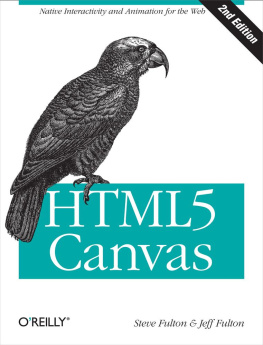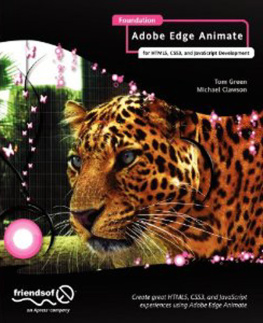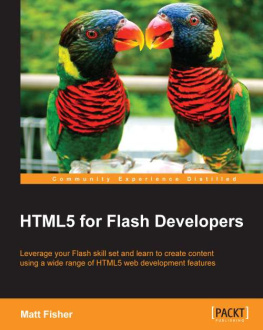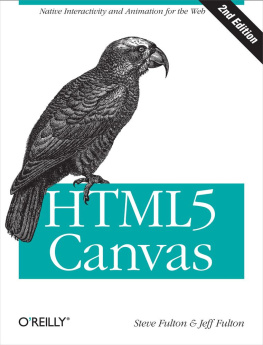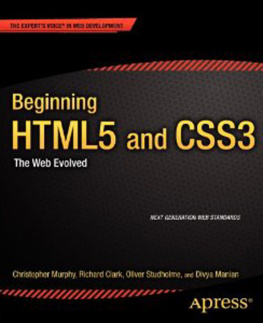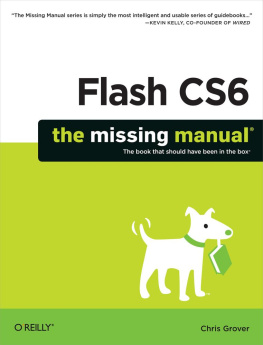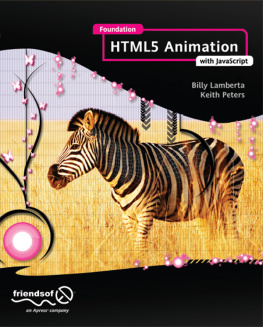What Is Wallaby?
Adobe Wallaby is a tool that is used to convert animated content created in Flash Professional to HTML5 so that it may be viewed using many of the standards-compliant browsers available today. In doing so, Wallaby enables you to use a mature animation tool, like Flash Professional, to produce compelling animations and creative content for the standard Web.
Put simply, Wallaby means that creating standards-compliant animations for the Web just got a lot easier for everybody.
Youll also be happy to know that all iOS-based devices are fair game as well. That means it is open season in terms of creating Flash content that can be displayed on the iPhone and iPad.
Until now, the big challenge in creating HTML5 animations was that you had to be a skilled JavaScript developer to pull it off. Assuming you were said developer, the amount of effort involved in creating HTML5 animations programmatically was still far too time-consuming, as it required writing code to draw your shapes, code to load any potential bitmap assets, and code for all the necessary translations of those items over time. Also, considering there was no built-in mechanism to manage the chronology of your animations, such as a timeline provides, to time your animations you had to monitor the count of a timer.
Creating HTML5 animations also proved challenging for designers, as it required them to write code. While there are some great "devsigners" out there who know both design and development, having to get involved with code to build an animation isnt exactly most designers cup of tea.
There is a greater issue at hand here, though: designers and developers are often cut from different cloth. A developer probably shouldnt be given creative control of any animation unless you want to see some very interesting results. At the same time, a designer might struggle with writing code when charged with having to create animations programmatically. When you consider this, you realize how the state of creating animations on the standard Web has been completely backward; it has forced developers to act as designers and designers to act as developers.
The good news is that if youre a creative type, Wallaby puts you right back in the game of creating animations for the standard Web. If youre a developer, provided you can learn some Flash Professional basics, you can spend just 30 minutes creating an animation rather than several hours. These are really big wins for designers and developers alike.
A Brief History of Flash and HTML5
These days, some people view Flash and HTML5 as competing technologies, even though a good number of the capabilities of these technologies are starting to converge. Its true that HTML5 has improved substantially over HTML4 and seeks to offer a lot of the same features of Flash. Whether one of these technologies will fully replace the other is unknown; it seems far more likely that they will simply continue to coexist. Regardless, there is no denying the fact that Flash has provided a means of creating complex animation and interactivity on the Web for many years. However, HTML has offered a standard and universally accessible format for representing data on the Web that is openly visible to search engines. Because of this, Flash and HTML have often been used in complementary ways; you will find numerous examples of sites leveraging HTML as a foundation to display data and Flash to achieve a more sophisticated level of animation or interactivity.
Concerns in Reaching Audiences
Although the number of people with Flash Player is significantly high, a portion of those users still dont have Flash. Therefore, its safe to presume that if youre targeting Flash users, some people will turn away because they wont make an effort to install the Flash plug-in or because their device simply doesnt support it. On the other hand, HTML5 works out of the box in modern browsers, and therefore, projects that seek to reach the largest audience possible tend to rely solely on HTML5 to power their content. In some cases, this can mean sacrificing some of the capabilities of Flash and, more specifically, some of things that were easier to do in Flash, such as creating animations, and designing a site with a lesser level of animation and interactivity.
The idea behind Wallaby is to give you some of the best of both worlds: use Flash to easily create engaging animations while maintaining the widest reach in terms of audience by targeting HTML5.
I would be remiss if I didnt mention that HTML5 doesnt solve every challenge in reaching our audience. Although the HTML5 specification is a standard supported by most modern browsers, many people still continue to use older browsers. For example, much to the dismay of many web developers, a significant number of people still use Internet Explorer 6, especially in the corporate realm. If your project must be viewable by browsers new and old, you might choose to avoid the features of HTML5 entirely and stick with HTML4. Although the number of people using older browsers will continue to decrease with time, gaps in your reachable audience will always exist. Just make sure to consider this when deciding on a technology for your project, and youll be fine.
Now, assuming youve already considered this and HTML5 is your weapon of choice, great; Wallaby will put you on the fast track to creating HTML5 experiences with engaging animations.
Browser Support
Wallaby in its current form makes heavy use of WebKit-specific CCS3 tags. This means that non-WebKit-based browsers such as Firefox and IE9 will not fully support Wallaby-generated animations.
However, browsers like Chrome, Safari, and Mobile Safari are fair game.
Conversion Limitations
While the ability to use a visual tool such as Flash Professional to create HTML5 simplifies the process of creating animations, its important to recognize that Wallaby cant be perfect at crafting the most optimized code possible. For highly complex animations where optimal performance is critical, its often best to get closer to the metal and work directly with JavaScript and HTML rather than using a visual tool to create this code for you.


